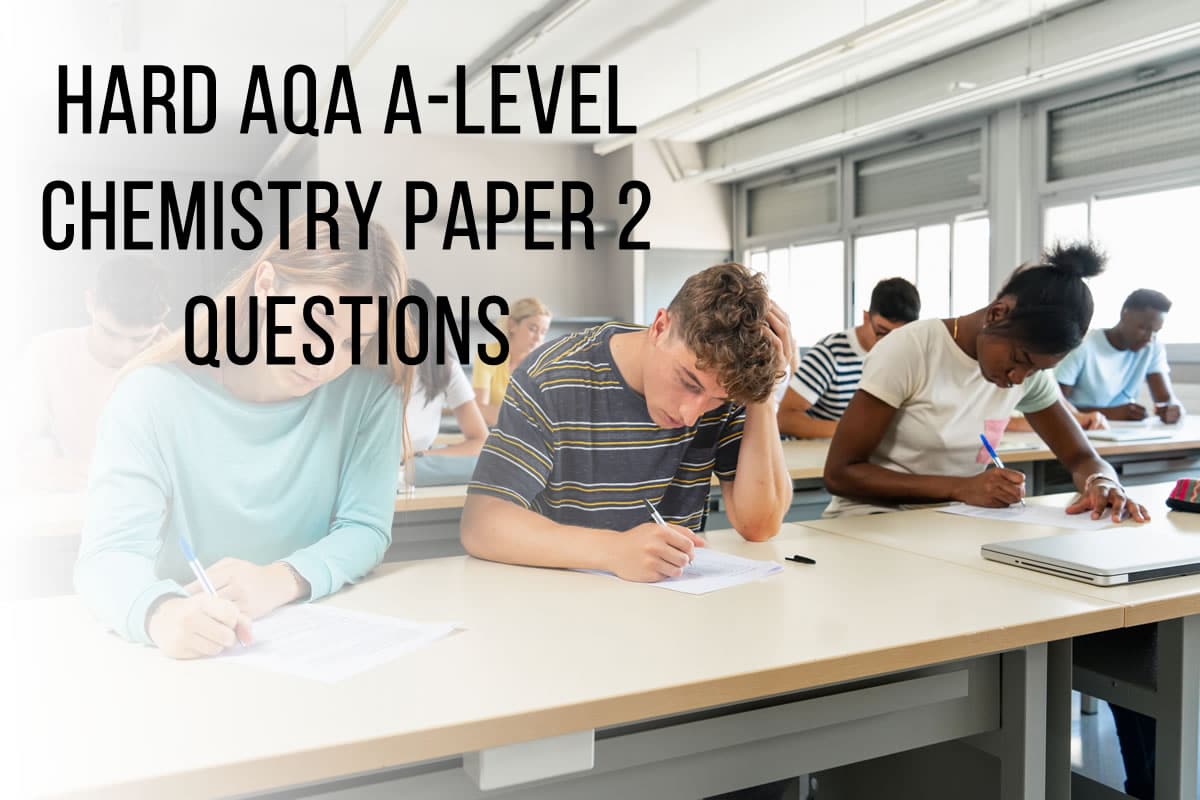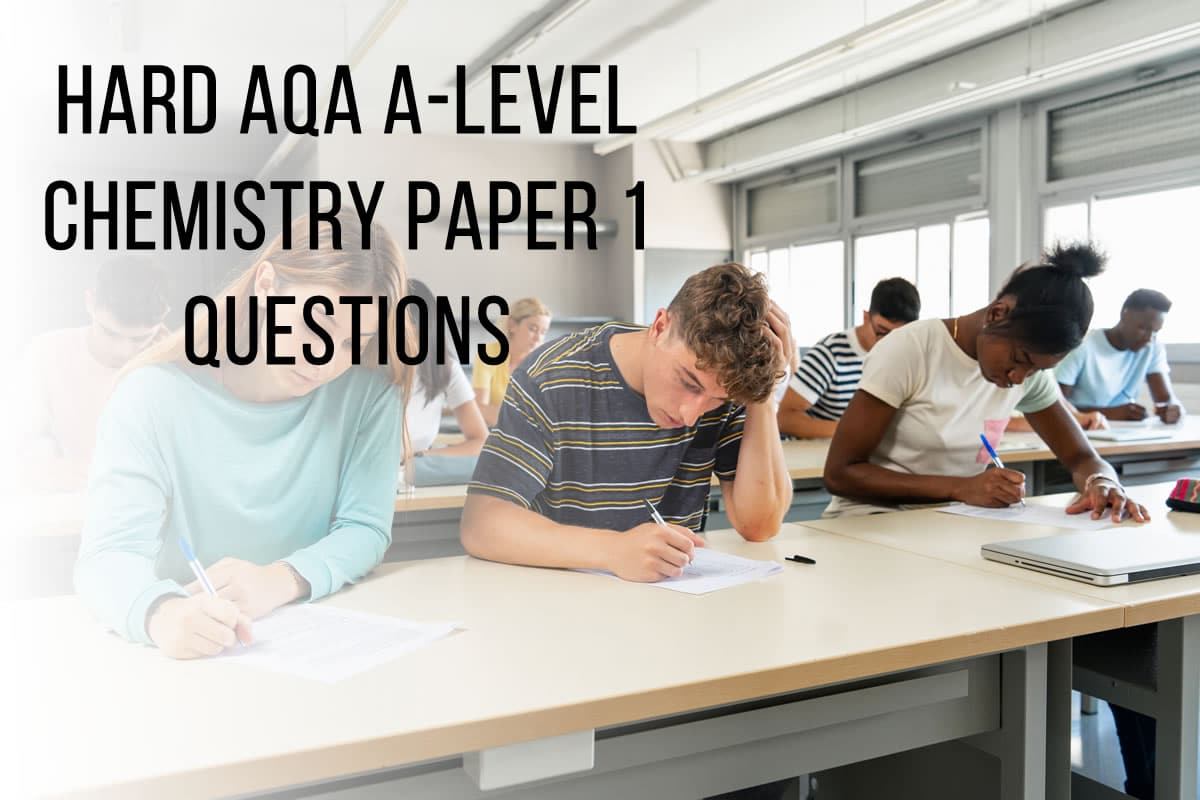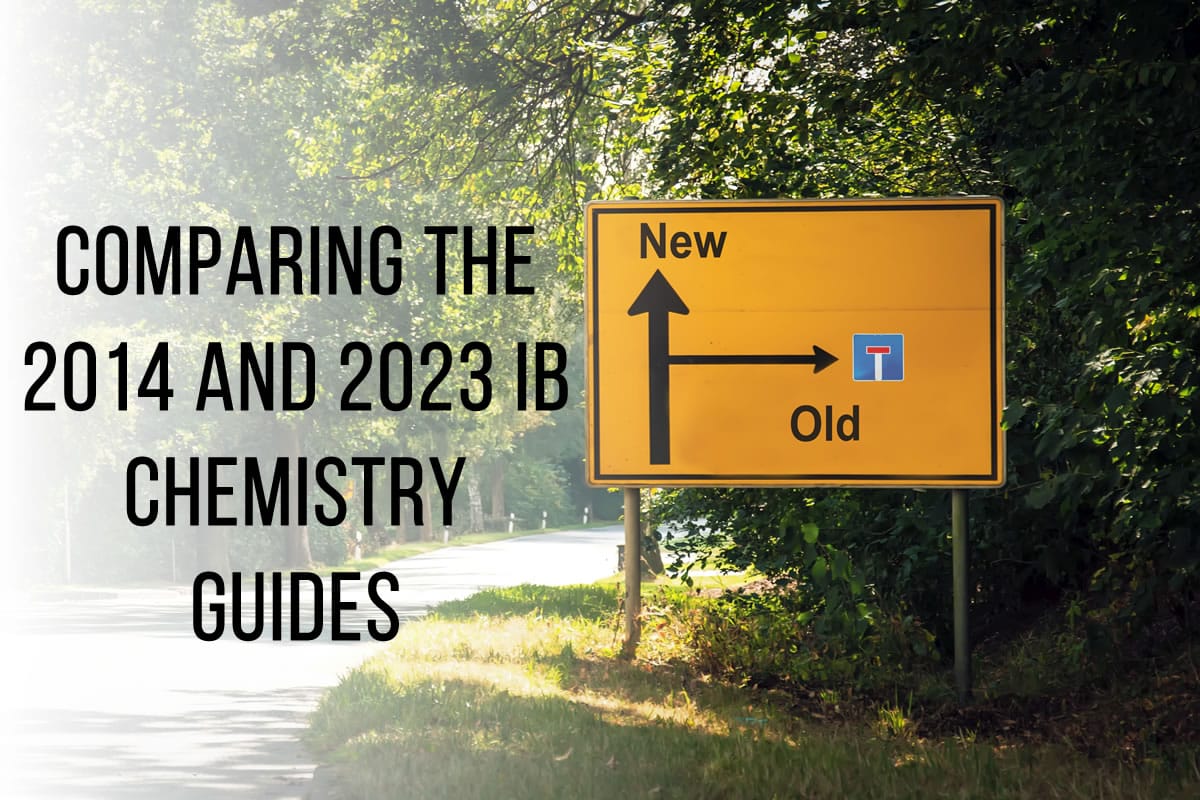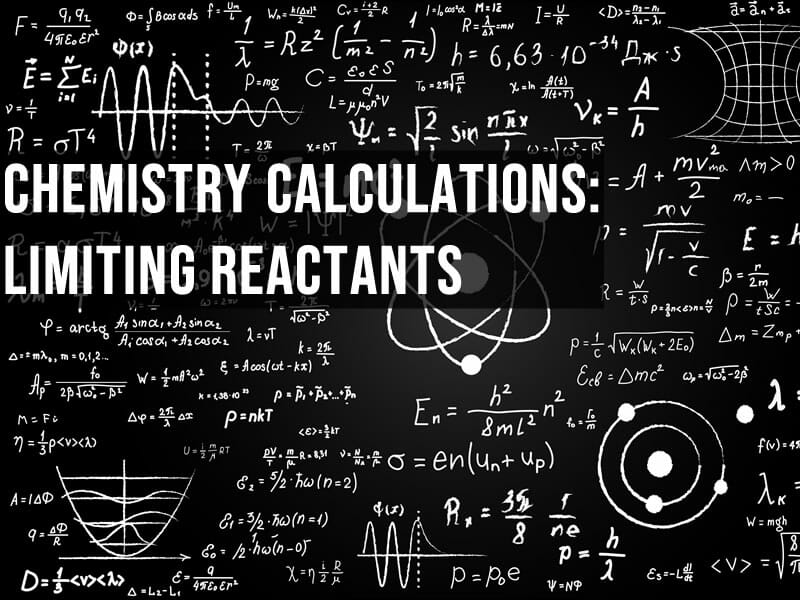AQA A-Level Chemistry Paper 3 Hard Questions
Key Points:
- Most of the difficult paper 3 questions are on practical chemistry.
- Organic chemistry questions make up the next highest category.
- Acids and bases, kinetics, and transition metals account for an approximately equal proportion of difficult questions.
- Students’ weaknesses in understanding and explaining practical chemistry are repeatedly stated throughout paper 3 examiner reports.
- Organic practical techniques prove most problematic, particularly the principles behind recrystallisation, reflux, and distillation.
- Questions involving graphs consistently cause problems for students.
Contents
Hard Practical and Organic Chemistry Questions Dominate Paper 3
Paper 3 is the one that students worry most about in my experience.
It has 40 marks of questions on practical chemistry, 20 marks of questions from any area of the syllabus, and ends with 30 multiple choice questions. The latter can really mess with your timing if you don’t have good exam technique, especially the ones that force you to do multiple calculations for a single mark.
Paper 3 questions are often synoptic, requiring you to make connections between different topics. This requires much deeper understanding of concepts.
It’s the practical questions that my students worry most about though. You need to know your apparatus and techniques inside out to score well on this paper, and be prepared to deal with questions on unfamiliar experiments.
The ‘Suggest…’ questions on this paper can be particularly challenging and answering them sometimes requires knowledge that would not normally be gained by doing the required practicals (e.g. understanding the impact of experimental errors). These question are therefore difficult to prepare for.
To help you, I’ve listed below all the areas of recurring difficulty, and the questions in each paper that examiners reported were the hardest. Trying out these questions will definitely stretch your knowledge, teach you a lot, and help you prepare for the worst!
Recurring Topics of Difficulty for Students
Acids and bases
- Calculations based on interpretation of pH curves.
- Understanding how acid strength influences enthalpy of neutralisation.
- Choosing the right indicator for a given titration.
- Use of the correct reaction arrow in dissociation equations of strong and weak acids.
- Extended calculations, such as calculating the mass of salt needed to produce a buffer with a given pH.
- Writing equations for reactions involving acids, including simple ones encountered at GCSE level.
- Novel, multistep calculations involving rearrangement of equations for pH and Ka.
Amount of substance
- Calculating percentage yield from organic reactions.
- Multiple choice questions requiring multistep calculations (e.g. involving the ideal gas equation) proved difficult, perhaps due to time pressure.
- Surprisingly, students struggled applying GCSE skills to A-Level situation, such as writing ionic equations for unfamiliar reactions.
- Deducing amount of oxygen needed for combustion reactions.
Bonding and structure
- Understanding how bond polarity and intermolecular forces influence properties such as solubility, retention times, and physical properties of condensation polymers.
- Explaining the shapes of molecules in terms of bonding pairs and lone pairs.
Electrode potentials
- Knowing standard conditions for operation of electrochemical cells.
- Writing balanced redox equations.
- Deducing a standard electrode potential from a cell potential.
- Designing experiments to determine a standard electrode potential.
- Using standard electrode potentials to explain reaction feasibility, such as the ability of certain transition metal ions to catalyse redox reactions.
Energetics
- Understanding why calorimetry cannot always to calculate enthalpy changes directly.
- Plotting graphs accurately to determine temperature changes for calorimetry calculations.
- Calculating enthalpy changes from experimental data, particularly involving limiting reactants.
- Knowing when an enthalpy change is considered a standard enthalpy change.
- Writing chemical equations for standard enthalpy changes, or recognising the latter from a given equation.
Graphs
- Plotting graphs accurately and drawing lines of best fit.
- Determining gradients of straight lines.
- Recognising that many mathematical formulae can be written to fit the equation of a straight line, y = mx + c, and using this to calculate variables.
Inorganic chemistry
- Halogen redox chemistry and the reactions of halide ions with concentrated sulfuric acid.
- Writing the equations for the reactions of period 3 oxides with water.
- The solubility of group 2 compounds.
- Relating group 2 compound solubility to pH.
Kinetics
- The strategy of using a large excess of one reactant so its concentration remains constant (pseudo-first-order kinetics) was not well understood.
- Understanding zero order reactions and their graphs.
- Determining rate constants graphically.
- Knowing which type of line of best fit to draw (curve versus line).
- Accurately determining the rate from the gradient of a concentration-time graph.
- Designing experiments to determine rate equations or activation energies.
- Understanding how first-order behaviour can be demonstrated from graphs.
- Clock reactions are generally problematic, particularly their chemistry, assumptions, methodology, and mathematical principles.
Organic analysis
- Understanding retention times and intermolecular forces/polarity.
- Remembering to state both the wavenumber range and the bond responsible for absorption in IR spectroscopy.
Organic chemistry
- Predicting and explaining the major product in electrophilic addition reactions.
- Naming alkene stereoisomers using the E-Z system.
- Identifying by-products from reactions based on their molecular formulae.
- Identifying oxidation products, particularly for polyfunctional organic molecules.
- Making predictions from organic formulae or names, such as chemical behaviour, physical properties, or spectroscopic details (e.g. number of NMR environments).
- Knowing the roles of reagents in organic reactions (e.g. HNO3 in benzene nitration).
- The rationale for certain reagent choices in organic synthesis.
- Finding the number of isomers for a given molecular formulae, particularly if constraints are applied (e.g. must give positive Tollens’ test).
- The equations showing formation of sulfur and nitrogen oxides (pollutants) from fossil fuel combustion.
- Understanding hydrolysis of polyesters and polyamides.
- Explaining how nucleophilic addition to carbonyls leads to stereoisomers and racemic mixtures.
- The shapes of organic molecules.
- Understanding the requirements for stereoisomerism in organic molecules.
- Drawing enantiomers accurately.
Periodicity
- The observations and equations for reactions of period 3 elements with oxygen.
- Comparing physical properties for period 3 elements.
- Understanding the acid-base properties of period 3 oxides and their reactions.
Practical chemistry
- Remembering to double the uncertainty when calculating percentage uncertainties for measurements that required two readings (e.g. temperature differences, titres, mass differences).
- Understanding how apparatus should be used correctly and safely.
- Designing calorimetry experiments to measure standard enthalpy changes.
- How to produce and use a calibration curve to find concentrations.
- Understanding the apparatus and techniques associated with organic synthesis, such as recrystallisation and the distinction between reflux and distillation.
- Understanding the function of anti-bumping granules.
- Explaining the post-reaction steps (work-up) for organic reactions, such as why sodium carbonate might be used, or how to use drying agents.
- Drawing apparatus accurately and ensuring apparatus is not sealed.
- Drawing apparatus to show the appearance of a meniscus.
- The steps involved in making a standard solution.
- Ensuring accurate measurements in volumetric analysis (e.g. correct use of a burette).
Redox
- Writing balanced redox equations and half-equations.
- Deducing oxidation states.
Thermodynamics
- Using the linear graph for ∆G = ∆H – T∆S to calculate ∆S.
- The factors affecting the difference between experimental and theoretical lattice enthalpy (charge density and ion polarisation).
- Construction of energy cycles that relate lattice enthalpy with enthalpy of solution and hydration.
Transition metals
- Identifying complex ion stereoisomers.
- Explaining the origin of colour.
- Use of E = hv to calculate energy of absorption.
- Understanding the action of cisplatin and the process it prevents, including diagrams to show cross-linking of nucleotides.
- Writing equations for ligand substitution reactions.
- Correctly deducing charges on complex ions.
- Recalling observations for aqueous chemistry of complex ions.
- Recalling the equations and principles behind autocatalysis.
- Homogeneous and heterogeneous catalysis.
| Question Number | Question Type | Topic | Examiner Comments |
|---|---|---|---|
| 1.1 | Extended response | Energetics | Only 12% answered correctly. Students did not recognize enthalpy change cannot be measured directly. |
| 1.3 | 6-mark Extended Response / Practical | Energetics | 37% failed to score. Many incorrect methods described instead of dissolving magnesium chloride in water and measuring temperature change. |
| 1.4 | Calculation | Thermodynamics | Gradient calculation was done well, but using delta G = delta H - T x delta S caused issues. Few recognized gradient = - delta S |
| 2.4 | Extended response | Electrophilic addition | Only 17% of students could explain the major product. |
| 2.5 | Extended response | Organic nomenclature | Even split between scores. Common issues with incorrect stems and naming the same isomer twice. |
| 2.6 | Extended response | Organic chemistry (by-products) | Oxidizing ability of conc. sulfuric acid not well recognized. |
| 2.7 | Extended response | Halogen redox reactions | Most incorrectly suggested sulfuric acid oxidizes chloride. |
| 3.1 | Extended response / Practical | Preparing an organic solid | Only 30% of students got this correct. Role of anti-bumping granules misunderstood. |
| 3.3 | Extended response / Practical | Preparing an organic solid | Needed to relate excess NaOH to ethyl benzoate reaction. Lacked specificity. Nearly 60% of students scored here. |
| 3.4 | Extended response / Practical | Preparing an organic solid | Many incorrectly referred to controlling temperature rather than flammability. |
| 3.5 | Extended response / Practical | Preparing an organic solid | Some incorrectly thought reflux is a separation method. |
| 3.7 | Extended response / Practical | Preparing an organic solid (solubility) | The hardest question on the paper. Only 1% scored both marks. Could state ionic but not explain insolubility of benzoic acid. |
| 3.8 | 6-mark Extended Response / Practical | Preparing an organic solid (recrystallisation) | 1/3 of students scored 4 or more marks, but 1/3 scored 0. Many students missed out steps, or the order of steps was incorrect. |
| 3.9 | Calculation | Percentage yield | Only 10% full marks. Calculation often done incorrectly. |
| 4.3 | Calculation | Acids and bases (pH curves) | Many used Ka expression instead of using titration data. |
| 4.5 | Extended response | Acids and bases (buffers) | pH = pKa at half-equivalence not well recognized. Only 26% scored. |
| 4.6 | Practical | Acids and bases (pH curves) | Many failed to show initial steep curve and buffering. Assumed half-equivalence incorrectly. |
| 5 to 34 | Multiple choice | Various | No commentary is provided on section B in this examiner report. |
| Question Number | Question Type | Topic | Examiner Comments |
|---|---|---|---|
| 1.1 | Extended response | Kinetics | Only 36.6% scored. Students simply restated the question rather than explaining effect of excess reactants. |
| 1.2 | Extended response | Kinetics | Only 9.7% scored both marks. Many described titration method rather than quenching. |
| 1.6 | Extended response | Kinetics | Just under 40% scored. Many assumed line must be straight rather than best fit. |
| 1.7 | Calculation | Kinetics | Finding gradient of curve was challenging. Many just divided numbers rather than drawing tangent. |
| 1.8 | 6-mark Extended Response / Practical | Kinetics (clock reactions) | A very challenging level of response question. Mean mark only 1.8/6. There were many convoluted methods described instead of clock reactions. |
| 2.1 | Extended response | Periodicity | Only 23.6% scored both marks. Equation not balanced and observations incorrect. |
| 2.3 | Extended response | Periodicity | Many compared Na vs Mg instead of oxides. 38.7% scored both marks. |
| 2.4 | Extended response | Periodicity | Confusion between molecular and giant structures evident. |
| 2.5 | Extended response | Period 3 elements | Some spoiled by referring to water bath and not slow heating. |
| 3.3 | Extended response / Practical | Preparation of cyclohexene | Only 42% correct. Vague answers about removing impurities. |
| 3.4 | Extended response / Practical | Preparation of cyclohexene | More correct answers on carbon dioxide release than on the reason for adding carbonate. |
| 3.6 | Extended response / Practical | Preparation of cyclohexene | Only 28.7% scored both marks. Diagrams were often missing key details, or showed sealed apparatus. |
| 3.7 | Extended response | Chromatography | 34.9% scored 0. Answers stated retention time is shorter without explaining why. |
| 3.8 | Extended response | Organic analysis (IR) | Only 43.7% gained the mark, with most students forgetting to give both the wavenumber range AND the bond. |
| 4.1 | Extended response | Energetics | Many students failed to plot the graph correctly. Only 33% scored 5/5. |
| 4.2 | Calculation / Practical | Percentage uncertainty | Only 19.3% scored. Failed to double uncertainty from thermometer readings. |
| 4.4 | Extended response / Practical | Percentage uncertainty | 58% scored 0. Misunderstood how to reduce % uncertainty. |
| 4.5 | Calculation | Calorimetry | Calculation layout was poor. Limiting reagent not recognized. 21.2% max marks. |
| 4.6 | Extended response | Acids and bases / Enthalpy changes | A challenging question testing extension concepts. Only 3.3% scored 2nd mark. Few recognized energy required to break bonds. |
| 11 | Multiple choice | Organic chemistry | 41.7% correct. Added -OH incorrectly to 2-methylbut-2-ene. |
| 14 | Multiple choice | Standard enthalpy changes | 47% correct. Confusion about standard states. |
| 22 | Multiple choice | Condensation polymers / Intermolecular forces | 51.2% correct. Hydrogen bonding requirements not recognized. |
| 23 | Multiple choice | Organic chemistry (electrophilic substitution) | 46% correct. Most students failed to recognise the role of nitric acid. |
| 25 | Multiple choice | Periodicity | Less than 50% found the correct ionic oxide. |
| 27 | Multiple choice | Transition metal (stereoisomers) | 36% correct. Most confused geometric and optical isomerism. |
| 28 | Multiple choice | Organic chemistry (isomers) | Under 50% were able to find the number of isomers. |
| 31 | Multiple choice | Solubility of group 2 compounds | 46.8% correct. Most students did not recognise that magnesium hydroxide and barium sulfate are sparingly soluble. |
| 32 | Multiple choice | Acids and bases (indicators) | 41.9% correct. Did not recognize low pH at end of strong acid-weak base titration. |
| 33 | Multiple choice | Thermodynamics (lattice enthalpy) | 23.1% correct. Concept of anion polarisation not well known. |
| Question Number | Question Type | Topic | Examiner Comments |
|---|---|---|---|
| 1.1 | Extended response | Amount of substance (ionic equations) | A surprising number of students could not write the ionic equation. |
| 1.2 | Extended response | Periodicity | Many students attempted to form sulfuric acid instead of sulfurous acid. |
| 1.3 | Extended response | Bonding and structure (shapes of molecules) | A significant minority showed 1 or 0 lone pairs on waters oxygen atom. |
| 1.4 | 6-mark Extended Response / Practical | Kinetics | Only ~17% scored in Level 3. Strange experimental methods suggested. |
| 2.2 | Extended response | Acids and bases | Many students used the wrong reaction arrow for the type of acid. |
| 2.3 | Extended response / Practical | Making a standard solution | Lack of detail let many down. Weighing descriptions problematic. |
| 2.4 | Calculation | Acids and bases | Most used rote methods without understanding principles. |
| 2.5 | Extended response | Acids and bases | ~50% failed to score. Many students were confused about pH vs hydrogen ion concentration. |
| 3.4 | Extended response | Electrode potentials | Student were weak on conditions needed for standard electrode potentials. |
| 3.5 | Extended response | Electrode potentials | Many students could not write balanced equation. |
| 3.7 | Calculation | Electrode potentials | Many calculated the wrong sign for the gradient. |
| 3.8 | Calculation | Electrode potentials | Rearranging the equation caused issues. |
| 4.2 | Extended response | Nucleophilic addition and chirality | Many missed the key phrase about ethanal structure and confused enantiomers, or drew them incorrectly. |
| 5.1 | Extended response | Acids and bases | Another balanced equation many could not write. |
| 5.3 | Extended response | Redox | A familiar reaction but >50% could not write the equation. |
| 5.6 | Calculation | Percentage uncertainty | Many did not double uncertainty from two readings. |
| 18 | Multiple choice | Transition metals. | Only 40% of students got this correct. |
| 22 | Multiple choice | Organic chemistry | Only 34% of students got this correct. |
| 34 | Multiple choice / Practical | Recrystallisation | Only 40% of students got this correct. |
| Question Number | Question Type | Topic | Examiner Comments |
|---|---|---|---|
| 1.1 | Extended response | Alkane combustion | 1/3 failed to score. Confusion about nitrogen source and need for high temperature. |
| 1.4 | Extended response | Transition metals (catalysis) | 85% scored only ½ marks. Defined heterogeneous but not catalyst. |
| 2.1 | Extended response | Group 2 compound solubility and pH | ~1/3 scored both marks. Vague answers about alkali metals seen. |
| 2.2 | Extended response | Periodicity (period 3) | Only 40% correct. The wrong formula for phosphorous(V) oxide was frequently seen. |
| 3.1 | Extended response | Transition metals (coloured ions) | Only 20% scored full marks. Key points about absorbed and transmitted wavelengths missed. |
| 3.2 | Calculation | Transition metals (coloured ions) | This calculation involving E = hv was not well answered, with incorrect equations or conversions between metres and nanometres seen. |
| 3.3 | Extended response / Practical | Colorimetry | Very challenging. Failed to describe full practical procedure. |
| 4.1 | Extended response | Transition metal (complex ions) | The name of process prevented by cisplatin was often not known. |
| 4.2 | Extended response | Transition metal (complex ions) | Many failed to appreciate the charge change when chloride is replaced by neutral water ligands. |
| 4.3 | Extended response | Transition metal (complex ions) | Very difficult. Most students ignored the need to show the complex binding the guanidine bases. |
| 4.4 | Extended response | Kinetics | A difficult question where over half scored 0 marks. Many gave no description of concentration vs time graph, or incorrectly described the appearance of rate-concentration graphs. |
| 4.6 | Calculation | Kinetics (Arrhenius) | There were many mistakes seen in determining the gradient. |
| 5.3 | Extended response | Calorimetry | Only 11% were able to explain why it was not a standard enthalpy change. |
| 5.4 | Calculation | Percentage uncertainty | Many did not double the uncertainty from the two readings. |
| 6.2 | 6-mark Extended Response / Practical | Electrode potentials | Only 9% reached Level 3, with many failing to describe the solution preparation method. |
| 6.3 | Extended response | Redox | Balancing the equation was challenging. |
| 6.4 | Extended response | Electrode potentials | Only 19% scored 2 or more marks. There were many confused descriptions of electrodes and species. |
| 7 | Multiple choice | Ideal gas equation | Fewer than 40% of students correctly calculated the number of moles. |
| 13 | Multiple choice | Acids and bases | Fewer than 40% found the correct statement about pH. |
| 28 | Multiple choice | Electrophilic addition | Fewer than 40% of students identified the major product. |
| Question Number | Question Type | Topic | Examiner Comments |
|---|---|---|---|
| 1.2 | Extended Response | Condensation polymers | Students lacked specificity in answers, with many just stating that polyesters are polar without detailed explanation. |
| 1.3 | Calculation | Redox titration | Majority scored over half marks, indicating a moderate level of difficulty. |
| 01.4 to 01.5 | Practical | Practical Chemistry (volumetric techniques) | Students showed weaknesses in practical chemistry concepts. |
| 1.6 | Practical | Redox titration endpoint | Only a quarter of students could correctly identify the colour change, a key practical skill. |
| 1.8 | 6-mark Extended Response | Transition metals / thermodynamics (chelate effect) | Half of the students could reach level 2 or above, with many struggling to express ideas about enthalpy changes clearly. |
| 3.1 | Extended Response / Practical | Separation and recrystallisation | Two-thirds of students scored poorly, confusing crystallisation with other methods like distillation. |
| 3.2 | Extended Response | Nucleophilic addition reactions | Students often confused HCN with KCN. |
| 3.3 | Extended Response | Nucleophilic addition mechanism | A third of students scored full marks, indicating a mixed response. |
| 4.1 | Extended Response | Halogens | Many students failed to correctly construct the overall equation. |
| 4.2 | Extended Response | Practical Chemistry | Students showed lack of clarity and precision in practical chemistry concepts. |
| 5 | Calculation | Acids and bases (buffers) | Many students could not calculate the mass of the salt needed. |
| 6.1 | Practical | Reflux and apparatus setup | Students missed specifics on safety concerns, like the improper placement of apparatus. |
| 6.3 | Practical | Reflux and apparatus setup | Many students incorrectly suggested adjustments to the apparatus, indicating confusion. |
| 12 | Multiple choice | Ionic bonding | <40% knew that all inorganic ionic compounds have giant structures. |
| 15 | Multiple choice | Shapes of organic molecules | <40% identified the planar molecule. |
| 25 | Multiple choice | Amount of substance / organic chemistry | <40% could find the molecule that required the most oxygen for complete combustion. |
| 26 | Multiple choice | Oxidation of alcohols | <40% found the correct oxidation product |
| 31 | Multiple choice | Organic reactions | <40% identified the compound that would react with NaOH. |
| Question Number | Question Type | Topic | Examiner Comments |
|---|---|---|---|
| 1.1 | Extended Response | Thermodynamics | Students struggled with clarity in defining enthalpy change, often incorrectly referencing standard conditions. |
| 1.2 | Calculation | Thermodynamics | Proper labelling in diagrams was a challenge, with mistakes in formulae and state symbols. |
| 1.4 | Calculation | Percentage uncertainty | Common error was failing to multiply the uncertainty by two for two readings. |
| 2.1 | 6-mark Extended Response | Testing for Ions | Difficulty in accurately describing tests for anions; failure to achieve higher response levels. Students often failed to use hydrated ion equations for the aluminium test. |
| 3.3 | Extended Response | Organic chemistry (stereoisomers) | Unclear explanations for lack of stereoisomerism in but-1-ene. |
| 3.6 | Extended Response | Organic chemistry (stereoisomers) | Challenges in drawing conventional 3D representations. |
| 3.7 | Extended Response | Nucleophilic substitution | Misconceptions in explaining relative rates of hydrolysis; focus needed on bond strengths. |
| 4.1 | Extended Response | Kinetics | Issues with correctly using frequency and successful in explanations caused many students to not gain the 2nd mark. |
| 4.5 | Extended Response | Kinetics | Challenges in reading scales and justifying first-order reactions led meant many students did not score the 2nd mark. |
| 5.2 | Extended Response | Transition metals (catalysis) | Students struggled to access all 6 marks for this question on autocatalysis due to brief and generic answers. |
| 5.3 | Extended Response | Electrode potentials | Confusion in using correct terminology and conventional forms in electrode potentials. |
| 7 | Multiple Choice | Amount of substance | Few students were able to find the correct acid. |
| 10 | Multiple Choice | Redox | Few students were able to work out the correct oxidation state. |
| 28 | Multiple Choice | Condensation polymers | Finding the polymer that could be hydrolysed proved challenging. |
| 33 | Multiple Choice | Organic chemistry | A small proportion of students chose the correct statement. |
How to Prepare for AQA A Level Chemistry Paper 3
“Students should now be familiar with the fact that this paper contains a significant proportion of marks related to the description of practical scenarios. The key to success with such questions is to be familiar with a wide range of practical techniques and to be able to write concise, accurate descriptions.” – AQA Examiner Report, Paper 3, 2020
That quote sums it up well – know your practical chemistry!
My guide to paper 2 has strategies for preparing for practical chemistry questions, as well as questions on organic chemistry and organic analysis.
My other guide on paper 1 has hints and tips to help you prepare for difficult physical and inorganic topics.
What Common Mistakes Do AQA Examiners Advise Students to Avoid?
- Read the question carefully! This is particularly important on this paper, which contains many lengthy and data-based questions. There were far too many instances where students lost marks on this paper due to simply misreading the question.
- Learn the entire syllabus, not just what has come up on previous papers.
- Ensure at least 50% of the available space is used when plotting graphs.
- Don’t rewrite the question as part of your answer, as it uses up space and time.
- Don’t include apparatus lists for practical descriptions as they will be mentioned when used.
- Only give one answer to avoid negating a correct answer with an incorrect one.
- Cross out mistakes and incorrect answers.
- Clearly label intermediate calculations so examiners understand what the number refers to.
- Number extra pages clearly and cross out rough work.
- Follow instructions carefully for filling in answers in Section B to avoid issues with scanning the papers.
Frequently Asked Questions
What are the key topics for AQA A-Level Chemistry Paper 3?
- Practical chemistry, organic chemistry, acids and bases, kinetics, transition metals, electrode potentials, periodicity, energetics, amount of substance, redox, inorganic chemistry (halogens especially), thermodynamics, bonding and structure, and organic analysis (NMR) make up the highest proportion of challenging paper 3 question.
- Knowing your required practicals (apparatus, techniques, common mistakes, sources of uncertainty) is vital.
How can I effectively revise for AQA A-Level Chemistry Paper 3?
- Ensure you have thorough and up to date notes for each topic.
- Notes on the required practicals are especially important. These must include labelled apparatus diagrams, explanations for apparatus choice, step-by-step methods, explanations for steps, common errors and their impact, uncertainties and how to reduce them.
- Do topical questions first to ensure complete coverage of each topic.
- Do complete paper 3s under timed conditions to get used to the time pressure.
- Practise multiple choice questions separately and learn to spot the multistep ones that are best left until last.
- Do relevant practical questions and multiple choice questions from other exam boards to further your knowledge.
- Practise plotting graphs and determining gradients! It’s a bit of a lost art, so you can easily take far too long if you’re out of practise.
What are the best resources for preparing for AQA A-Level Chemistry Paper 3?
For practical chemistry, I recommend the AQA Practical Chemistry book (this is the ‘official’ guide)
I also recommend the excellent Chemrevise guide, which Neil Goalby regularly updates
How can I improve my problem-solving skills for AQA A-Level Chemistry Paper 3?
Solving and analysing difficult problems is really the best way. This develops your analytical problem-solving skills, and reveals connections between concepts that increases your understanding.
Use this guide, and my other guides linked above, to find and answer the most difficult questions from AS Papers 1 and 2, and A-Level Papers 1 to 3.







Leave A Comment